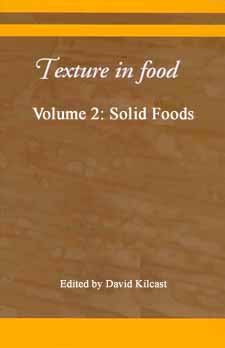Features of Texture in Food Volume 2: Solid Food:
- Summarizes research on what influences texture
- Provides practical strategies for improving product quality
- Reviews ways of controlling the texture of fruits and vegetables
Part 1 book reviews research on understanding how consumers experience texture when they eat, and how they perceive and describe key textural qualities such as crispness.
Part 2 considers the instrumental techniques used for analysing texture. It includes chapters on force/deformation and sound input techniques, near infrared spectroscopy (NIR), nuclear magnetic resonance (NMR) and magnetic resonance imaging (MRI).
The final part examines how the texture of particular foods may be better understood and improved. A number of chapters review ways of controlling the texture of fruits and vegetables, including the role of plant structure and compounds, the handling of raw materials and technologies such as freezing and vacuum infusion. A final group of chapters discuss the texture of cereal foods, including bread, rice, pasta and fried food.
Contents
Part 1: Consumers, texture and food quality
Chapter 1: Measuring consumer perceptions of texture: an overview
- Texture and food quality
- Perception and sensory assessment of food texture
- Tests and test procedures
- Instrumental measurement of texture
- In vivo texture measurement
Chapter 2: Consumers and texture: understanding their perceptions and preferences
- Problems with consumer descriptions of texture
- Investigating consumer descriptions of texture
- Tests and test procedures
- Understanding consumer preferences
- Challenges to understanding consumer preferences
Chapter 3: Texture, mastication and consumer perceptions of food quality
- Mastication and texture
- The mastication process
- Measuring mastication
- Chewing, swallowing, salivation and bolus formation
- Mastication and particular foods
Chapter 4: Understanding and measuring consumer perceptions of crispness
- Characterisation and determination of crispness
- Methods of data correlation, evaluation and analysis
- Case study: breaded chicken nuggets
Part 2 Instrumental techniques for analysing texture
Chapter 5: Force/deformation techniques for measuring texture
- Structural and mechanical characterisation of solid foods
- Destructive measurements
- Non-destructive measurements
Chapter 6: Sound input techniques for measuring texture
- Sound and its detection
- Destructive testing
- Non-destructive testing
- Application of sound measurement techniques
Chapter 7: Near infrared (NIR) diffuse reflectance in texture measurement
- Introduction: spectroscopy and NIR
- Application of NIR to cereals and their products
- Application of NIR to fruit and vegetables
- Application of NIR to meat
- Application of NIR to other foods
Chapter 8: Nuclear magnetic resonance (NMR) and magnetic resonance imaging (MRI) in texture measurement
- Methods and analysis
- Application of NMR: texture determination of solid foods
- Application of MRI: texture determination of solid foods
Chapter 9: Modelling food texture
- Role of modelling in texture analysis
- Factors affecting texture
- Effects of enzymes on texture
- Applying models to predict texture
Part 3 Understanding and improving the texture of particular foods
Chapter 10: Plant structure, fruit and vegetable texture
- Measurement of texture
- Plant structure
- Cellular basis of crispness, juciness and mealiness in fruit tissue
- Cellular stability during processing
- Improving cell adhesion
Chapter 11: Plant compounds and fruit texture: the case of pear
- Variations in pear texture
- Measuring and modelling fruit firmness
- Chemical compounds affecting firmness: the example of Japanese pear
- The effect of cultivation and storage on fruit texture
- Use of near infrared spectroscopy (NIR) to evaluate textural properties
Chapter 12: Controlling the texture of fruit and vegetables: the role of oxidising enzymes
- Distribution of polyphenoloxidases (PPOs) and peroxidases (PODs) in plants and plant cells
- Biochemical and physiological role of PPOs and PODs
- PPOs and PODs: structure and mechanisms of action
- PPOs, PODs and texture development
- Controlling PPO and POD activity
- PPOs and PODs: implications for food texture
Chapter 13: Improving fruit and vegetable texture by genetic transformation
- Tools of genetic modification
- Approaches to the manipulation of texture: the tomato
- Other approaches to the manipulation of texture
Chapter 14: Raw material quality and the texture of processed vegetables
- Vegetable texture determined by starch
- Vegetable texture determined by cell wall polysaccharides
- Vegetable texture affected by phenolic reactions
Chapter 15: Improving the texture of processed vegetables by vacuum infusion
- Vacuum infusion technology
- Applications to improve texture
Chapter 16: Improving the texture of frozen fruit: the case of berries
- Introduction: the effects of freezing and thawing on berry texture
- Maintaining texture: conventional pre-freezing treatments
- Maintaining texture: alternative pre-freezing treatments
- Application: frozen berries and jams
Chapter 17: Improving the texture of processed fruit: the case of olives
- The texture of table olives
- Factors affecting the texture quality of raw olives
- Influence of processing on table olives
- Improving texture
Chapter 18: Improving the texture of bread
- Textural characteristics of bread and other cereal-based foods
- Definitions of texture
- Measuring texture
- Influence of processing and storage
- Improving texture
Chapter 19: Analysing and improving the texture of cooked rice
- Criteria for evaluating rice quality
- Hydration of rice
- Factors affecting cooking quality
- Testing texture quality
- Problems and challenges
Chapter 20: Improving the texture of pasta
- Measuring the texture of cooked pasta
- Influence of raw materials
- Influence of processing
- Trends in consumer preference
Chapter 21: Improving the texture of fried food
- Measuring texture
- Factors influencing texture
- The use of response surface methodology (RSM)
- A case study: fried gluten balls
Index
 to see other books related to food product development
to see other books related to food product development